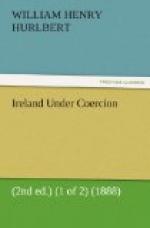After an early dinner, I set out with Lord Ernest to see the Morley-Ripon procession. It was a good night for a torchlight parade—the weather not too chill, and the night dark. The streets were well filled, but there was no crowding—no misconduct, and not much excitement. The people obviously were out for a holiday, not for a “demonstration.” It was Paris swarming out to the Grand Prix, not Paris on the eve of the barricades; very much such a crowd as one sees in the streets and squares of New York on a Fourth of July night, when the city fathers celebrate that auspicious anniversary with fireworks at the City Hall, and not in the least such a crowd as I saw in the streets of New York on the 12th of July 1871, when, thanks to General Shaler and the redoubtable Colonel “Jim Fiske,” a great Orange demonstration led to something very like a massacre by chance medley.
Small boys went about making night hideous with tom-toms, extemporised out of empty fig-drums, and tooting terribly upon tin trumpets. There was no general illumination, but here and there houses were bright with garlands of lamps, and rockets ever and anon went up from the house-tops.
We made our way to the front of a mass of people near one of the great bridges, over which the procession was to pass on its long march from Kingstown to the house of Mr. Walker, Q.C., in Rutland Square, where the distinguished visitors were to meet the liberated Lord Mayor, with Mr. Dwyer Gray, and other local celebrities. A friendly citizen let us perch on his outside car.
The procession presently came in sight, and a grand show it made—not of the strictly popular and political sort, for it was made up of guilds and other organised bodies on foot and on horseback, marching in companies—but imposing by reason of its numbers, and of the flaring torches. Of these there were not so many as there should have been to do justice to the procession. The crowd cheered from time to time, with that curious Irish cheer which it is often difficult to distinguish from groaning, but the only explosive and uproarious greeting given to the visitors in our neighbourhood came from a member of “the devout female sex,” a young lady who stood up between two friends on the top of a car very near us, and imperilled both her equilibrium and theirs by wildly waving her hand-kerchief in the air, and crying out at the top of a somewhat husky voice, “Three cheers for Mecklenburg Street! Three cheers for Mecklenburg Street!”
This made the crowd very hilarious, but as Lord Ernest’s local knowledge did not enable him to enlighten me as to the connection between Mecklenburg Street and the liberation of Ireland, I must leave the mystery of their mirth unsolved till a more convenient season.




